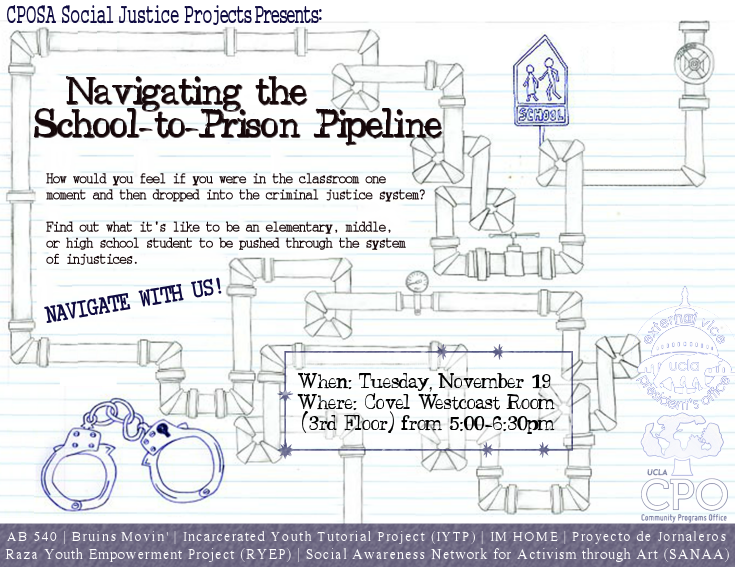The “School-to-Prison Pipeline” is a concept that highlights the systematic forces that push disadvantaged students out of school and into the juvenile and criminal justice system. There are certain policies, such as “zero tolerance”, in affect that place large punishments on small offenses; thus, leading to the mass incarceration of the youth.
Yesterday evening in Covel Commons, Incarcerated Youth Tutorial Program (IYTP) and other CPOSA social justice projects held a workshop entitled “Navigating the School-to-Prison-Pipeline,” to highlight and emphasize the impact of mass incarceration on minority communities. Michael Oshiro, an IYTP director and event coordinator, said, “[Our] primary goal is to bring awareness to a critical issue that not many students know about. I hope this event inspires students to get involved because we have been stagnant, and now it is time for action.”
The main focus of the workshop was a “make shift pipeline” where participants were able to “choose their path”; however, no matter what path was chosen, the participant was still caught up in the system. At every stop point, the participant was given three options on how to respond to the situation. Every response was different, but the educational path was still deferred.
The scenarios were framed as such:
Your mother tells you to take your cell phone to school so that she can call you from the hospital where your sister has been admitted after a severe asthma attack. Your phone rings as you are walking down the hall. A teacher approaches you and confiscates the phone reminding you that having a cellphone is against school rules. The next day you receive a letter telling you that, because of your school’s zero tolerance policy, you have been suspended for ten days for a cell phone violation. You…
- Explain to your principal that you needed your cell phone so that your mom could call you.
- Accept the suspension spend your ten days at home trying to keep up with your schoolwork.
- Accept the suspension spend your ten days hanging out with friends in your neighborhood who have dropped out of school.
Nonetheless, scenarios like these are familiar to many students. According to the American Civil Liberties Union (ACLU), “Students who have been suspended are three times more likely to drop out by the 10th grade than students who has never been suspended.” With the increasing number of suspension rates for students of color, two to three times more than other students, the prison population expands with Black and Brown inmates.
So the question is, if there are numerous policies and practices in place that contribute to the “school-to-prison” pipeline, how can we preserve education in the public school system and avoid incarceration of the disadvantaged youth?
Compiled by: Jessica Rayside/ E.I.C
Contributed details by: Jameelah Howard/ Nommo Staff

